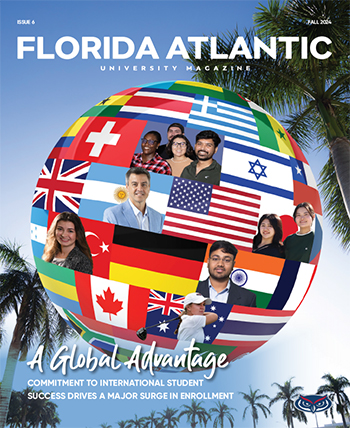1/27/2025
Florida Atlantic: Guardians of the Rays
Scientists Explore Stingrays on the Move
Two studies exploring the Atlantic cownose ray (Rhinoptera bonasus), whitespotted eagle ray (Aetobatus narinari) and giant manta ray (Mobula birostris), are revealing the dynamic nature of marine ecosystems in Bermuda and Southeast Florida.
Florida Atlantic University scientists are unraveling the mysteries of these graceful rays on the move and paving the way for informed decisions to protect future generations.
For hundreds of years, natural history records have identified the whitespotted eagle ray as the sole ray species in Bermuda, until now. Researchers from FAU Harbor Branch Oceanographic Institute have discovered another species and a novel migration pattern using citizen science, photographs, on-water observations and the combination of morphological and genetic data. The study is the first to provide evidence that the Atlantic cownose ray has recently made a new home in Bermuda.
Because cownose rays are highly migratory and prefer tropical and temperate seas, they are typically restricted to continental shelves. Bermuda, which is comprised of multiple islands, is located in the northwest region of the Sargasso Sea. It is separated from the continental United States by about 1,000 kilometers.
Findings, published in the journal Frontiers in Fish Science, presented intriguing questions about the rays’ presence as seasonal visitors or full-time residents. Based on the islands’ mild sea temperatures and remoteness, researchers suggest that cownose rays will likely reside in Bermuda for extended periods.
"We don’t exactly know how many Atlantic cownose rays are actually present in Bermuda and whether it’s a single group that keeps getting re-sighted in various locations or whether the species is more broadly distributed across inshore sounds and harbors," said Matt Ajemian, Ph.D., lead author, associate research professor and director of the Fisheries Ecology and Conservation Lab at FAU Harbor Branch.
Advanced genetic analysis from tissue samples of five individual cownose rays between 2021 and 2022 revealed interesting behaviors including pupping and potential mating activities, suggesting a rapidly growing population establishing itself in Bermuda’s waters.
Oceanographic phenomena, including shifts in wind patterns and storm activities, may have played pivotal roles in facilitating this migration. Ajemian draws parallels with historical events like the shipwreck of the Sea Venture in 1609, suggesting that adverse weather conditions might have similarly guided cownose rays toward Bermuda’s inviting waters.
"Perhaps these Atlantic cownose rays encountered bad weather just like the Sea Venture did and found their new paradise in Bermuda," Ajemian said. "In the end, we don’t know if it was a single event or a combination of conditions that brought these animals here, but either way it’s an incredible trip."
The collaborative study’s findings indicate a sustained presence of cownose rays in Bermuda since 2012, prompting calls for further research into their ecological impact and interaction with native species like the whitespotted eagle ray. Given their low reproductive rate and potential competition for resources, understanding these dynamics is crucial for effective conservation management.
Meanwhile, in Southeast Florida, extensive aerial surveys conducted by researchers in Florida Atlantic’s Charles E. Schmidt College of Science are providing a birds-eye view of the abundance of two important ray species in this region. The surveys, from Miami to the Jupiter Inlet between 2014 and 2021, are helping to quantify the distribution and abundance of giant manta rays and whitespotted eagle rays.
In Florida waters, giant manta and whitespotted eagle rays are protected species. To ensure effective management, it is crucial to collect data regarding where they are found and how many there are.
Findings of the study, published in the journal Environmental Biology of Fishes, revealed consistent sightings of rays, with giant manta rays showing a preference for southern waters and whitespotted eagle rays distributed more evenly along the coast. Despite encountering humanpopulated areas like Fort Lauderdale and Miami, these charming creatures displayed resilience in their habitat choices.
The study also explored factors influencing ray abundance, revealing no clear correlations with sea surface temperatures or chlorophyll-a concentrations, which can lead to harmful algal blooms. However, understanding seasonal variations and habitat preferences is critical for mitigating human-induced threats to these rays.
"The presence of these large, slow-moving giant manta rays in the nearshore environment makes them susceptible to injuries caused by human interactions, including boat propeller injuries and entanglement with fishing gear," said Stephen Kajiura, Ph.D., senior author and professor of biological sciences. "A knowledge of their seasonal distribution and abundance will help to identify and protect key habitat areas. Data from our study may contribute valuable information that can be used to effectively manage both of these charismatic species in Florida and elsewhere."
For more information, email dorcommunications@fau.edu to connect with the Research Communication team.

